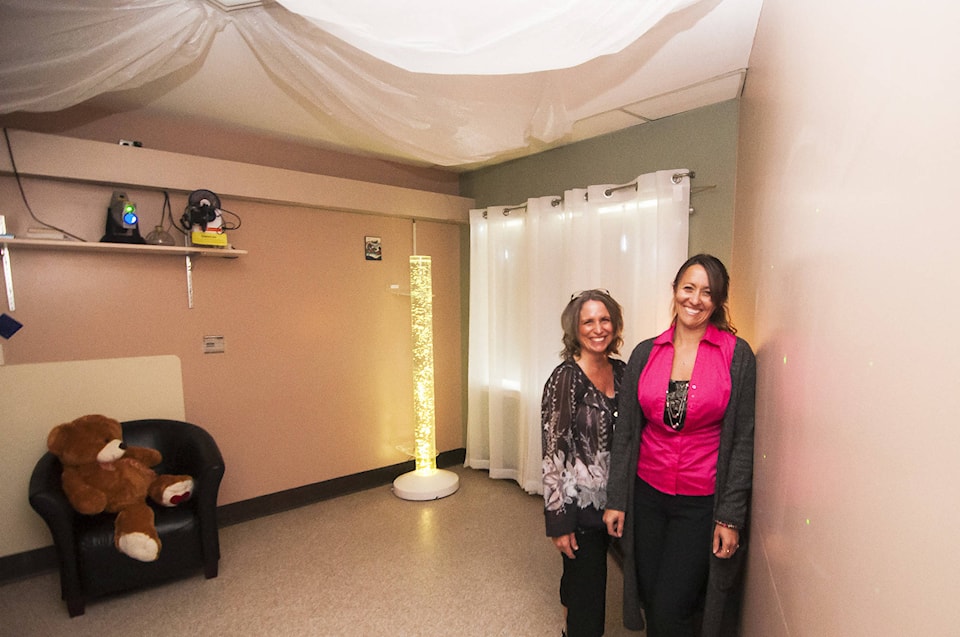Sometimes all it takes is a quiet place to regroup.
At Bastion Place, that oasis is called the “Snoezelen” room.
In use for the past three years, thanks to funding from the Shuswap Lake Health Care Auxiliary, the room is proving to be a successful tool in calming agitated residents.
“When they become agitated, have crying outbursts or are just over-stimulated in the public area, we take them in there and right away it helps them become calm and relaxed because it’s a completely safe environment,” says recreation therapist Michele Bojda of residents, some of whom no longer have the intellectual reasoning or cognitive ability to calm their own fears and agitation.
The Snoezelen room was developed in the late 1970s by two Dutch therapists who experimented with a sensory tent, with the goal of increasing enjoyment and sensory experiences for people with intellectual disabilities.
The term Snoezelen is a contraction of the Dutch verbs “snuffelen” (to seek and explore) and “doezelen” (to relax).
As Bastion Place staff have learned, Snoezelen multi-sensory products and environments can be used to calm and reduce agitation through the use of gentle light, soothing sound, relaxing smell and touch.
The Snoezelen room features back-lit curtains music, aromatherapy, fibre optic cables that light up and can be held and shaped by residents and a six-foot colour-changing bubble tube. A projector shows pictures of the ocean, snowflakes and stars on the wall.
“As soon as you go in, it’s calming and it stimulates all the senses, which also helps,” Bojda says. “Heavy blankets make you feel like you’re being hugged; there’s a warm sensation of being touched.”
Another Bastion Place recreation worker Shelley Pertelson heard about Snoezelen therapy several years ago and decided it was something she really wanted to introduce to Bastion before retiring.
“I had a vision and I did all the research and figured out where to get the right supplies,” Pertelson says, noting one of Bastion’s suppliers helped design the room. Her daughter supplied a defuser and the essential oils. “I worked with the manager and we started with a defuser and Christmas lights.”
Once Pertelson and manager Shannon Maslyk firmed up their needs, a proposal was taken to the ladies auxiliary, who were enthusiastic and “pretty much donated everything.”
Pertelson and Bojda agree Bastion staff are thrilled with the room.
“You take somebody with aggressive behaviour into the room, put on their favourite music, say it’s country, and it calms them down because they’re in a space that feels like a home-like environment,” Bojda says, noting the period near sundown is often a particularly challenging time when agitated behaviour is referred to as sundowning. “That’s because they think their spouses are coming home and they have to get things ready; they just know they’re supposed to be busy and doing something, but they no longer know what that is.”
Bojda says if staff can find what each individual needs, they can help them feel more at home. Bojda says while the room is mainly used for sensory therapy, it is home to several successful programs and an oasis for people who just need to get away from the noise and confusion of living in a large, busy facility.
“Thursday night, I had eight residents for Golden Expressions, where I ask questions and they answer them from their past – away from all the noise,” she says. “It’s a great asset to have the room where everyone is at ease and enjoying themselves.”
One of Bojda’s most rewarding memories is of a male resident who was sundowning when she went on shift.
“His behaviour was busy and it could turn into aggressive behaviour,” she says. “I had the aromatherapy going first, I got everyone in the room calm and I wanted him to be part of the group. He slept for three hours.”
Bojda says the calming effect of the room allows staff to more easily provide care for residents and can also stimulate more social interaction with staff and other residents.
“It helps improve behaviour and mood and raises self-esteem,” Bojda says. “I haven’t seen anything not work; it’s a real big wonderful experience to have this in the building for these residents who mean the world to us.”
And, adds Bojda, when the room is not in use by residents, staff members have been known to take their coffee breaks to renew themselves in the quiet, calming space.
